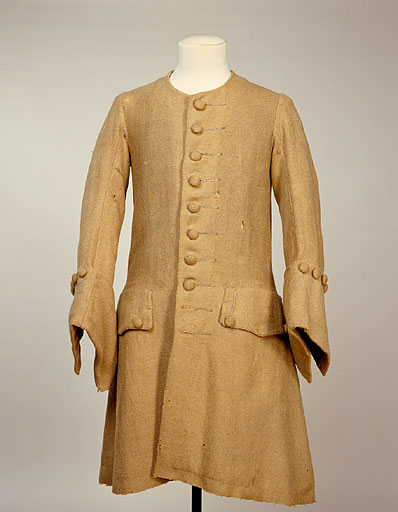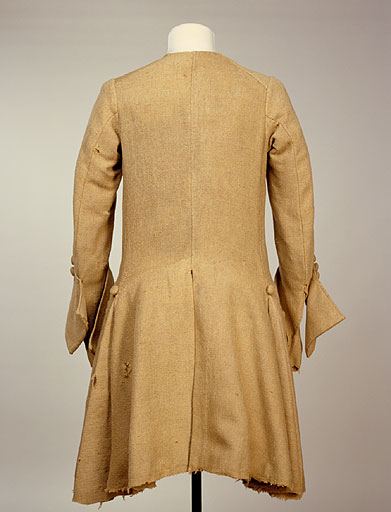coat
Summary
Fawn homespun woollen cloth; fronts each in one section, fastening from below waist to round neck with ten cloth covered double-dome buttons with buttonholes; pocket, fawn cotton, at hip each side, with slightly shaped flap, with slightly shaped flap, with imitation buttonhole and button each end; flared skirt; back in two sections, flared, open at centre below waist; double thickness in skirt back and front; pleats inserted in side seams of skirt, with button at top of pleating; long sleeves in two sections open at outer wrist almost to elbow, with very wide turnback cuff; top edge trimmed at outer arm with four imitation vertical buttonholes and buttons. Fabric worn into holes. This is a difficult garment to interpret. Although likely genuine, some of the interlinings (double-faced satin, cotton corduroy, cotton jean) and some of the cotton sewing threads in the seams seem 19th century. Also some of the cut such as the curved openings under the pockets. Possibly therefore made up later as a reproduction in the 1840s/50s. The cut however is pretty accurate, so the 19th century maker must have had an 18th century original to copy. Fabric: Shetland type, coarse pulled wool; Warp: Z twist; Weft: slight S twist; Plain weave; 20 ends/ 20 picks.
Display Label
This man's coat is a very remarkable survival, not only because it is an early garment, but also because it is made out of wool which was spun and woven at home and not professionally manufactured. The fabric is straight off the loom and has not been finished or dyed, and the garment is unlined so that it feels and looks rather primitive, resembling sacking. Nevertheless this simple cloth has been constructed into a very fashionably cut coat with deep pocket flaps, wide cuffs and full pleats in the coat-skirts. Remarkably, it exhibits all the fashionable elements for a man's coat of the 1740s, made in a fabric worthy of the stable! The fashionable woven silk suit below, dating from a little later, shows how accurate the silhouette has been achieved in this unsophisticated wool. Although unfortunately we do not know the wearer, the wool fibres are Scottish in provenance, and it is tempting to imagine a smallholder or croft-farmer making his own cloth and then commissioning a family member or an itinerant tailor to produce a coat for him to an up-to-date fashionable design. He would, no doubt, have been proud to have worn something that was the product of his own endeavour, and it was a way for someone of severely limited means to afford to dress smartly and fashionably.
Object Name
coat
Date Created
1730-1750
Dimensions
Length: 97.5cm
accession number
1954.1106
Place of creation
England
Medium
Legal
© Manchester Art Gallery




